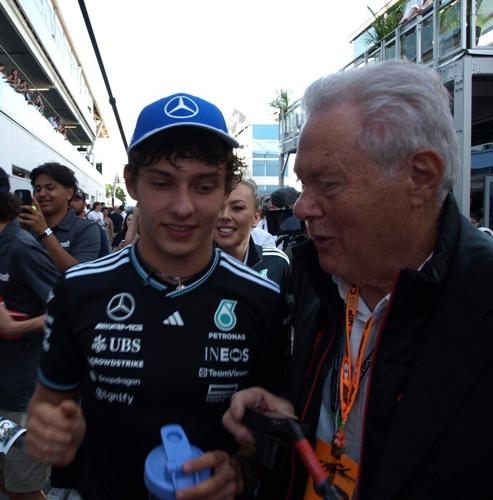When most drivers get a new car, they glance at the ownerÔÇÖs manual, toss it back into the glove box, and hope they never actually need to read it.
Formula One rookie Liam Lawson wanted to do just that, but knew that getting the most out of his Visa Cash App Racing Bull car meant poring over the manual that explains all the knobs, dials and buttons on his new rideÔÇÖs complex steering wheel.
ÔÇťWe definitely have to read it: I remember getting the manual; it is literally a book this thick,ÔÇŁ said the grinning 23-year-old, holding his hands about 10 centimetres apart.
ÔÇťI donÔÇÖt like reading, but I had to read that one. There’s many switch changes that you have with all the buttons on the steering wheel, but then thereÔÇÖs other menus in there where multiple switch changes unlock other menus. Basically, it’s just about understanding all the combinations of things that you have do ÔÇö itÔÇÖs very complicated.ÔÇŁ
Learning the intricacies of their new steering wheel represents only one in a number of challenges facing first-year drivers at the pinnacle of motorsport.
The last step on a ladder up through feeder categories, the move to F1 takes huge leaps in several areas.
ÔÇťAll the steps on the way to F1, are all quite a natural progression, and then the step to F1 is just times 100 on so many levels,ÔÇŁ Lawson said.
ÔÇťOn the technical side, itÔÇÖs obviously much more advanced than everything else, the speed of the cars is incredibly fast, and the team of people you’re working with is much larger. ItÔÇÖs just everything upscaled by a lot and then thereÔÇÖs media as well ÔÇö itÔÇÖs everything like that and quite hard to prepare for.ÔÇŁ
MoneyGram Haas F1 Team rookie Oliver Bearman, 20, found it difficult to explain the final leap in terms that road car drivers can understand, because even the lowest levelÔÇÖs car performance far outpaces anything on the street.
ÔÇťA Formula 4 car is like nothing you would ever experience on the road; itÔÇÖs indescribable how amazing that car is,ÔÇŁ said Bearman, who made his F1 race debut with Ferrari in the 2024 Saudi Arabian Grand Prix after one of the teamÔÇÖs regular drivers, Carlos Sainz, was diagnosed with┬áappendicitis that required surgery.
ÔÇťThen you double it by going to Formula 3. You do the same to Formula 2, and then the step from F2 to F1 is like 10 times ÔÇö itÔÇÖs the biggest step of all ÔÇö and gets you to the most incredible cars out there.ÔÇŁ
And getting the most out of those incredible F1 cars can prove elusive to a young driver.
Mercedes-AMG Petronas F1 TeamÔÇÖs Kimi Antonelli, who turns 19 in August, has definitely ridden a roller-coaster in his rookie season, driving like a steely veteran and shining on some weekends while looking like an inexperienced and impetuous teen on others.
He drove an impressive race in JuneÔÇÖs Canadian Grand Prix in Montreal to score his first career podium and then took out reigning four-times world champion Max Verstappen with a race-ending, first-lap mistake two weeks later in Austria. He also struggled to understand the softest compound in tire supplier PirelliÔÇÖs stable, and could not find speed in his car on some tracks earlier in the season.
His Mercedes team curtailed media interviews to help him cut the noise and focus on driving, while the young racer looked to a familiar face for advice and reassurance.
ÔÇťMy dad is a big rock for me. HeÔÇÖs been there, teaching me everything since I was very little, since karting,ÔÇŁ Antonelli said of his father, a former Italian sports car racer.
ÔÇťI feel itÔÇÖs very important to have someone like him at the track, especially in my rookie season in F1, because itÔÇÖs a completely new world ÔÇö super intense and difficult ÔÇö itÔÇÖs like being in water full of sharks: If you donÔÇÖt perform, you get eaten.ÔÇŁ
Lawson knows all about the sharks. He took over for an underperforming Daniel Ricciardo at Racing Bulls with six races left in the 2024 season before being promoted to the Red Bull team to start 2025. After two subpar performances in 2025, he found himself replaced by Yuki Tsunoda and back with the Racing Bulls. That demotion looks great compared to Alpine rookie Jack Doohan, who failed to impress his bosses and now watches from the sidelines as another driver, Franco Colapinto, occupies his F1 seat.
While driving for a top team does increase AntonelliÔÇÖs profile, a dimmer spotlight with a smaller team often gets traded for other issues not faced by outfits higher on the grid.
ÔÇťI wouldn’t say its necessarily easier or harder to be up or down the grid, because every team has its own challenges,ÔÇŁ Bearman said.
ÔÇťThe higher up teams have a faster car thatÔÇÖs easier to drive in a way where, for us, we have a more difficult car to drive. OK, the pressure isn’t on us, but it’s more difficult to put a result together.ÔÇŁ
Veteran driver Nico Hulkenberg feels that F1ÔÇÖs recent surge in popularity also means more pressure because many more eyes now stare at the fishbowl.
ÔÇťItÔÇÖs a much bigger stage,ÔÇŁ said the Stake F1 Team Kick Sauber driver who scored his first career podium in the 2025 British Grand Prix on July 6.
ÔÇťItÔÇÖs harder when you come in now with how the sport has developed and grown. It was a bit smaller and a bit more chilled back then [in 2010].ÔÇŁ
The growth also extends to the travel schedule. F1 only ran 19 races when Hulkenberg joined the series which grew to 24 this year and goes from mid-March to early December.
For his part, Bearman chooses to look on the bright side of the long season.
ÔÇťAlthough I spend a bit too much time on planes than I probably would like, we get to see some incredible places that I would never be able to visit as a normal 20 year old,ÔÇŁ he said.
ÔÇťI’m very lucky and happy to have this experience, so all the jet lag is worth it. ThereÔÇÖs a few tired days, but it’s certainly worth it.ÔÇŁ
































To join the conversation set a first and last name in your user profile.
Sign in or register for free to join the Conversation